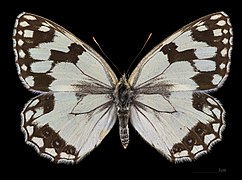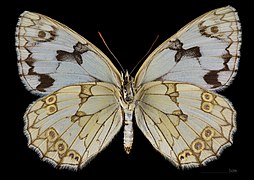Melanargia lachesis
| Melanargia lachesis | |
|---|---|

| |
| Scientific classification | |
| Domain: | Eukaryota |
| Kingdom: | Animalia |
| Phylum: | Arthropoda |
| Class: | Insecta |
| Order: | Lepidoptera |
| Family: | Nymphalidae |
| Genus: | Melanargia |
| Species: | M. lachesis
|
| Binomial name | |
| Melanargia lachesis Hübner, 1790
| |
| Synonyms | |
| |
Melanargia lachesis, the Iberian marbled white, is a butterfly species belonging to the family Nymphalidae.
Distribution
It can be found on the Iberian Peninsula and the south of France.
Description
The length of the forewings is 25–28 mm. Seitz- M. lachesis Hbn. (= nemausica Esp.) (38b). Lighter than galathea, even than the lightest forms of the same. The black discocellular anguliform spot of the forewing constricted where it is bent. Hindwing entirely white, apart from the interrupted submarginal band; the base very sparingly dusted, the markings of the underside however shine through in the male. In Spain, Portugal and South France. – The specimens with creamy yellow ground-colour, which are somewhat rarer than the chalky white canigulensis Obth.; from the Pyrenees.[2]
-
Melanargia lachesis ♂
-
Melanargia lachesis ♂ △
-
Melanargia lachesis ♀
-
Melanargia lachesis ♀ △
Biology
The butterflies fly in one generation from June to August.They occur from the plain to about 1,600 meters above sea level. They prefer dry, flowering, natural meadows that can also be overgrown with bushes. The larvae feed on various grasses.
References
- . Retrieved 20 November 2021.
- ^ Seitz. A. in Seitz, A. ed. Band 1: Abt. 1, Die Großschmetterlinge des palaearktischen Faunengebietes, Die palaearktischen Tagfalter, 1909, 379 Seiten, mit 89 kolorierten Tafeln (3470 Figuren)
 This article incorporates text from this source, which is in the public domain.
This article incorporates text from this source, which is in the public domain.
External links





